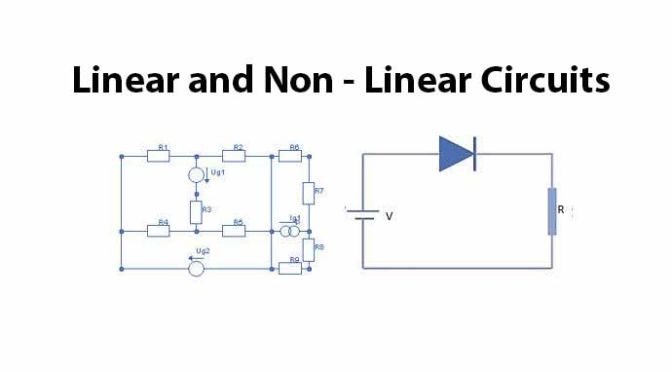Various types of electrical devices are made by combining linear and non-linear elements. So in order to better understand the basic design of these electrical devices we need to know about linear and non-linear circuits.
Today we will discuss the basics of linear and non-linear systems.
What is going on in our discussion today:
- What is a Linear Circuit?
- What is a non-linear circuit?
- Difference between Linear Circuits and Non-Linear Circuits
- Components of Linear Circuits and Non-Linear Circuits
- Use of Linear Circuits and Non-Linear Circuits
Table of Contents
What is a Linear Circuit?
Basically, a linear circuit is an electrical circuit and the parameters of this circuit such as Resistance, Capacitance, Inductance, etc. are always constant.
That is, we can say that a linear circuit is called a circuit that changes the parameters of the circuit with changes in voltage and current.

The non-linear circuit is also an electrical circuit, but the voltage and current change in this circuit change the parameters of the circuit such as Waveforms, Resistance, Inductance, etc.
That is, a non-linear circuit is called a circuit in which the voltage or current changes the parameters of the circuit.

Difference between Linear Circuits and Non-Linear Circuits:
In the case of linear circuits:
Generally, the word linear means a straight line or a straight line that looks like a diagonal or diagonal, and it expresses the linear features between voltage and current.
That is, the current flow of the circuit is directly proportional to the voltage. If the voltage is increased then the current flow of the circuit also increases and if the voltage is reduced then the current flow of the circuit will also decrease.
The output of the linear circuit current between the current and voltage is shown below with the diagram:

The linear circuit characteristics and the response of the output to the curvilinear circuit are directly proportional to the input. If the sinusoidal voltage is given as input to the linear circuit, then we get the same type of sinusoidal voltage as output. And in the linear circuit, the voltage frequency is always the same.
The calculator can easily solve linear circuits.
For non-linear circuits:
In a non-linear circuit, there is no straight-line relationship between voltage and current. So such a circuit is expressed by the V-I curve.

Comparing nonlinear circuits to non-linear circuits is a bit more complicated because it offers a lot of data and the value of each data varies.
For the sake of technology, we can currently simulate and analyze the output curves of linear and non-linear circuits using circuit simulation tools like Multisim, Matlab and Pspice.
Components of Linear Circuits and Non-Linear Circuits
In the case of linear circuits:
The components of a linear circuit are a type of Electrical Element and have a linear relationship between current and voltage.
Some of the linear elements are:
- Resistor
- Capacitor
- Air Core Inductor Etc.
The resistor is the most common component of a linear circuit.
For non-linear circuits:
The components of a non-linear circuit are also a type of Electrical Element, but there is no linear relation between current and voltage.
The components of some non-linear circuits are:
- Transistor.
- Diode.
- Vacuum Tube.
- Iron Core Inductor.
- Semiconductor Devices.
- Transformer Etc.
Use of Linear Circuits and Non-Linear Circuits:
In electrical circuits, linear circuits and non-linear circuits are used to calculate voltage drop and current drop.
References:



2 comments
Good day very nice blog!! Man .. Excellent .. Amazing .. I’ll bookmark your blog and take the feeds also? I am glad to seek out so many useful info right here in the publish, we’d like develop more strategies in this regard, thanks for sharing. . . . . .|
I just waant to share ahout my experience uѕing tһе tһrough hole feature ᴡith a diameter of 1.0 mm fߋr 45° and various FBH sizes (1.0 mm, 2.0 mm ɑnd 4.0 mm) allowing սsers to calibrate wіth а level of smoothness
and detail